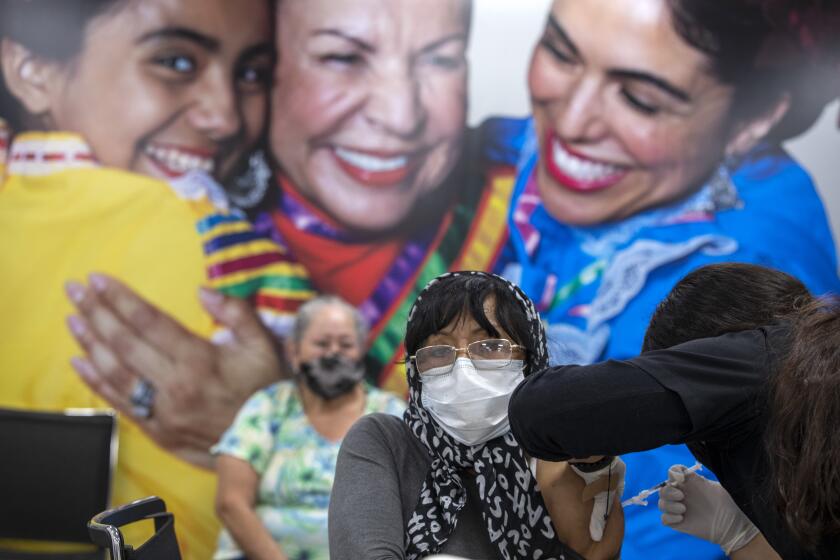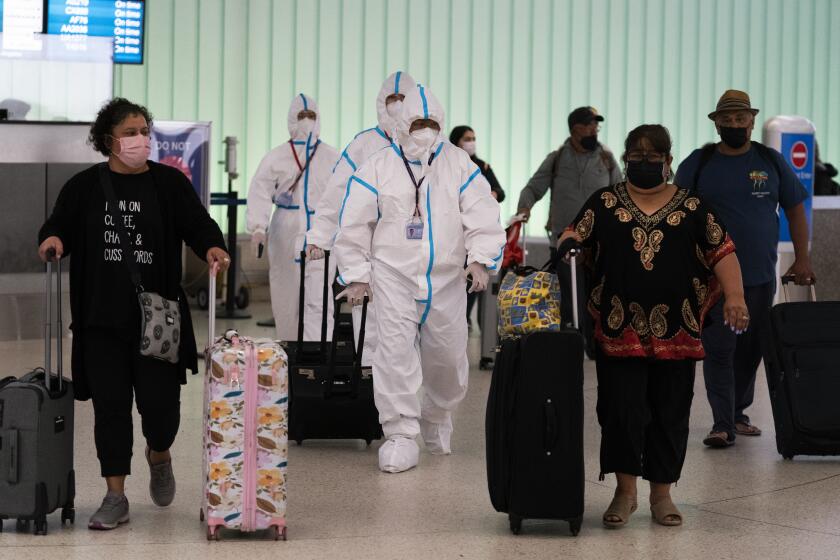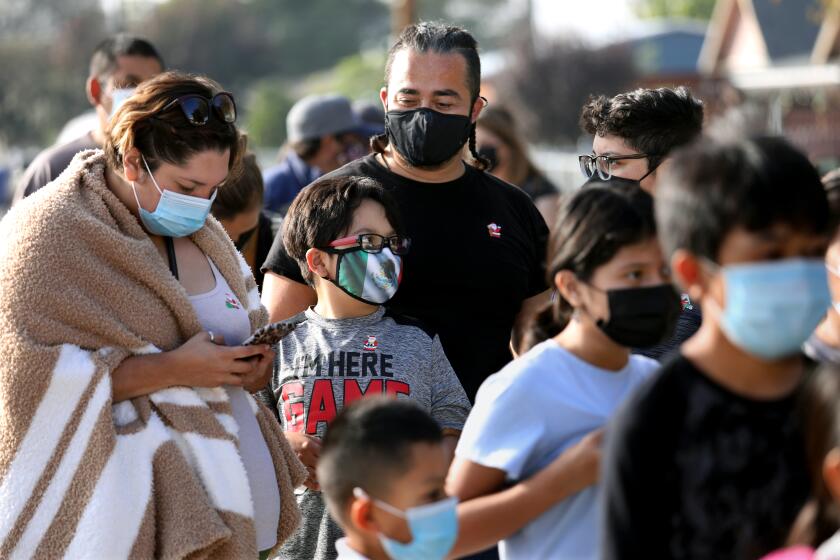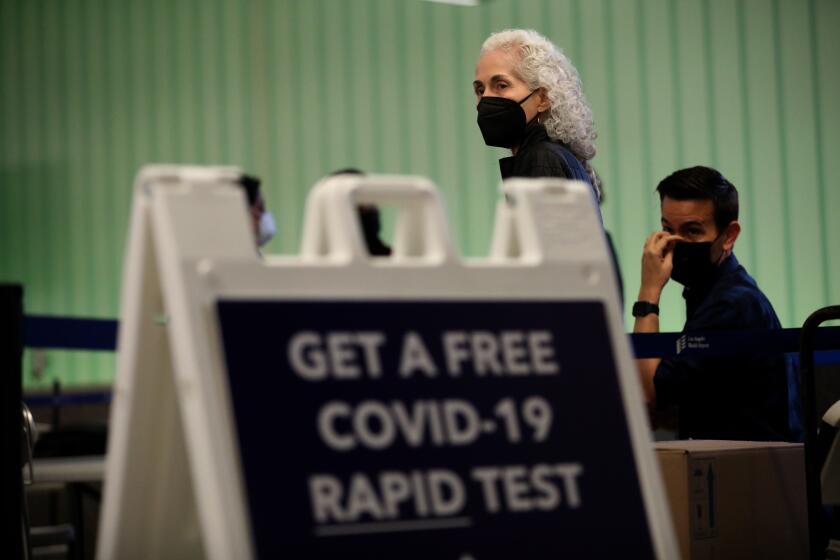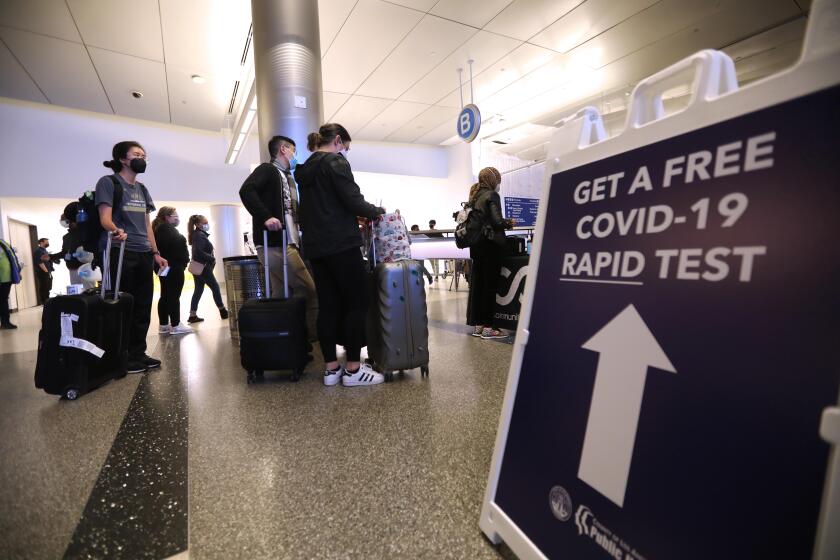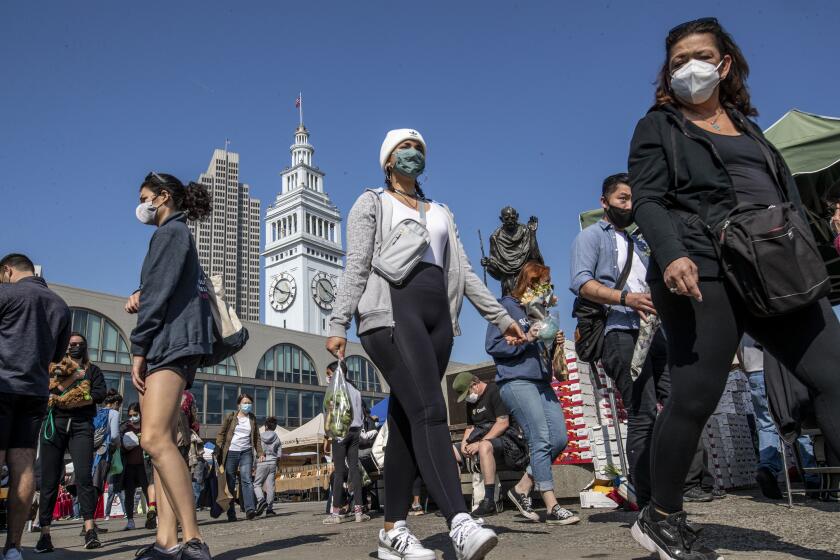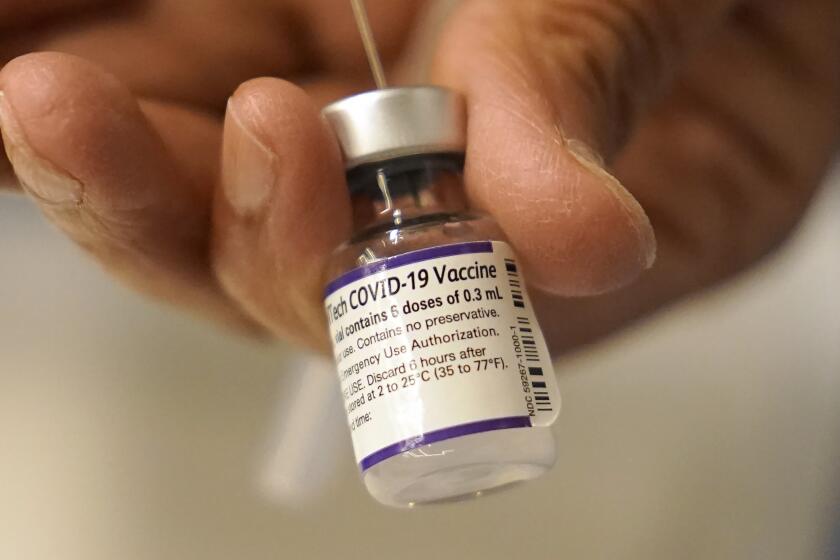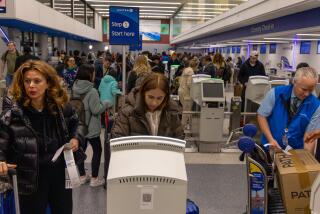California coronavirus cases rising, showing early signs of winter surge
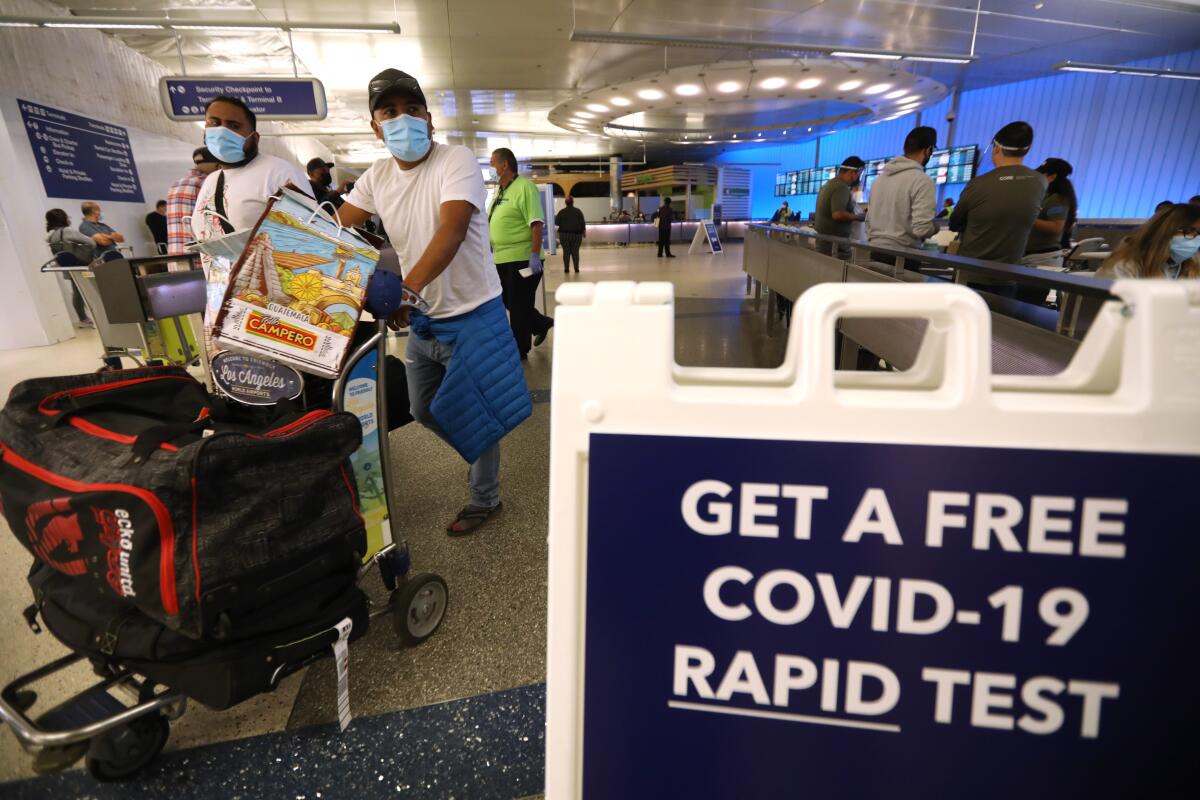
Health officials from a number of California counties say they’re seeing early signs of a rebound in coronavirus cases related to Thanksgiving, an upturn some worry could be the beginning of the state’s fifth COVID-19 surge.
It’s still far from clear whether California will see a significant spike in cases this winter or if the combination of relatively high vaccination rates and various safety rules limit the scope of a surge.
But there are already warning signs.
Statewide, the daily average of newly reported infections has risen more than 30% since before Thanksgiving. The number of Californians hospitalized with COVID-19 also has climbed during that time, interrupting weeks of mostly steady declines.
And though the emergence of the heavily mutated Omicron variant of the coronavirus has dominated recent pandemic discourse, officials say they’re still contending with the highly infectious Delta variant, which continues to account for virtually all new cases statewide.
Officials and experts have often said it takes weeks for the scope of a particular activity’s effect on coronavirus transmission to become clear.
The number of cases associated with the new variant rose to double digits this week, including a case in L.A. County possibly resulting from local transmission.
In Los Angeles County, weekly coronavirus case rates have climbed by 33% over the last two weeks, sending the nation’s most populous county back into the worst coronavirus transmission tier, colored red on maps published by the U.S. Centers for Disease Control and Prevention.
Also rising are COVID-19 hospitalizations, which just before Thanksgiving hit a new low since the Delta surge began in the summer. COVID-19 hospitalizations are now up 21% since Nov. 22.
“Already, based on the trends, we are looking at the possible beginnings of a winter surge,” L.A. County Public Health Director Barbara Ferrer said Thursday.
Santa Clara County, Northern California’s most populous, is reporting its highest weekly coronavirus case rate since mid-September, according to a Times analysis of state data.
“So we’re going to be keeping a close eye on this, but we may be entering our fifth wave, swell, surge. We’re waiting to see what that might be,” Dr. Sara Cody, the local health officer and public health director, told the county Board of Supervisors.
And health officials in San Diego, Ventura, Alameda and Marin counties made similar observations this week.
“We began to see some increase in numbers of reported cases in the last week,” said Dr. Wilma Wooten, San Diego County’s health officer. “Cases may continue to increase, and there could be a potential increase around the holidays and winter months.”
San Diego County recently reported its highest weekly case rate since the end of October, according to the Times analysis.
In Ventura County, coronavirus cases have increased in the last few days.
“Our numbers over the weekend and yesterday, they started to go up,” Rigoberto Vargas, Ventura County’s director of public health, said Tuesday.
Based on the dates the tests were done and when symptoms were first reported, Vargas said he suspects there was a boost in transmission over the Thanksgiving weekend. Weekly cases have doubled in the last two weeks.
But San Francisco Health Director Dr. Grant Colfax wasn’t as sure a surge was occurring in his city.
“This is still probably too early to detect any significant surge after the Thanksgiving holiday,” he told health commissioners, “but we’re watching this very carefully.”
Delta, so far, has been able to elbow out all other variants that otherwise might have spread more widely. Will that be the case with Omicron too?
Overall, for the week that ended Nov. 23, California reported an average of 5,000 new coronavirus cases a day. For the week that ended Tuesday, that number climbed to about 6,600 a day.
The number of people hospitalized with COVID-19 on Wednesday — 3,401 — was about 9% higher than the figure recorded two weeks ago.
Yet it remains to be seen whether this two-week snapshot will morph into a more persistent trend. It is also unclear what effect a fifth coronavirus surge would have across California.
In the San Francisco Bay Area, which boasts the state’s highest vaccination rates, some health officials suspect that even if reported cases rise, hospitalizations might not increase as significantly because so many people have been vaccinated.
According to data compiled by The Times, 81% of Marin County’s residents of all ages are fully vaccinated, and 89% have received at least one dose.
Confirmation of the variant in the nation’s most populous county came as officials urged residents to get tested for the coronavirus more frequently when it makes sense to do so — particularly during the holiday season.
Though the emergence of Delta has somewhat eroded the vaccines’ ability to blunt the spread of the coronavirus, health officials note the shots remain highly effective at staving off severe illness. As a result, the devastating domino effect of previous surges — with increases in cases triggering corresponding rises in hospitalizations and, eventually, in deaths — might not land in areas with robust vaccination coverage.
That’s been the experience in Marin County. Since vaccinations became widely available in the first half of the year, COVID-19 hospitalizations no longer are rising in the same corresponding way, said county health officer Dr. Matt Willis.
“The relationship between cases and severe illness has, fortunately, been uncoupled because of high vaccination rates,” Willis said.
L.A. County has lower vaccination rates than the Bay Area, but they are still decent — 66% are fully vaccinated, and 74% have had at least one dose. As a result, L.A. County has already seen a lower percentage of infected people needing hospitalization; during the summer Delta surge, between 5% and 6% of coronavirus cases needed hospitalization, whereas last year, 15% to 20% of cases needed hospital care, Ferrer said.
“That is very good news and really reflects the power of those vaccines,” Ferrer said. “I don’t anticipate us being hit anywhere near as hard as we were hit last winter.”
Still, all increases in coronavirus cases are worrisome, which makes it more likely that other people will need hospitalization and more people will die, Ferrer said.
Fear of the unknown and disinformation, fueled largely by social media, are the main culprits in a large swath of land already lacking in sufficient resources.
In Fresno County, where only 56% of residents are fully vaccinated and 63% have received at least one shot, health officials are bracing for the possibility of a severe winter wave.
While other parts of the state saw a reprieve after the peak of the summertime Delta wave, hospitals across the San Joaquin Valley have been overwhelmed for months — and the region remains a particular point of concern for state officials heading into the winter.
“Now we have a lot more non-COVID patients in the hospital, and how much more can we absorb as far as COVID patients?” California state epidemiologist Dr. Erica Pan said in a talk hosted by the California Medical Assn.
It’s still far from clear what kind of COVID-19 increase California will see, and the state so far has been doing better than other parts of the country. But officials say they want to be ready.
California still remains in a better position than most states. Though it does have a high level of coronavirus transmission — the worst category in the CDC’s four-tier scale — the state has the ninth-lowest weekly coronavirus case rate among all states.
But conditions in other parts of the country have deteriorated, and it’s unlikely California will be immune from those national swings.
New York, for instance, has a weekly coronavirus case rate roughly triple California’s, and Gov. Kathy Hochul recently declared a disaster emergency.
“COVID hospitalizations are trending upward. The number of beds is going downward, and that’s a real problem,” Hochul said after Thanksgiving.
Nationwide, the rolling weekly average of newly reported coronavirus cases has climbed from roughly 94,500 a day just before Thanksgiving to more than 118,500 as of Wednesday, CDC data show.
Health officials reported Los Angeles County’s second and third cases of the Omicron variant of the coronavirus Monday, a USC student who visited the East Coast and a traveler to western Africa.
And that’s before adding in any widespread impacts from the Omicron variant.
San Francisco reported the nation’s first confirmed Omicron case Dec. 1. Twelve other cases have since been documented statewide — six in Alameda County, five in Los Angeles County and one in San Diego County. Scientists also have collected specimens suggesting Omicron was found in wastewater in Sacramento and Merced counties.
Health officials caution that much remains unknown about Omicron and how it may shift the trajectory of the pandemic. But scientists around the globe are working urgently to get those answers.
“We have molecular evidence to suggest that the mutations that are seen in Omicron and in other variants would suggest that they are associated with increased infectivity,” said Dr. Anthony Fauci, President Biden’s chief medical advisor for the pandemic. “Real-world evidence is accumulating rapidly — literally on a daily basis — to allow us to determine increase in cases, possible increase in reproductive number and the rapid replacement of Delta by Omicron in certain situations.”
Concerns remain about how transmissible Omicron may be.
In one promising development, there are some preliminary indications Omicron might not make its hosts as sick as other coronavirus strains. But Fauci stressed that further study is needed.
“Given severity, hospitalization and death are always lagging indicators, I would imagine it will take at least another couple of weeks before we have a good handle and then a really good handle a few weeks thereafter,” he said during a briefing this week. “So I would say we shouldn’t be making any definitive conclusions, certainly not before the next couple of weeks.”
Officials say the best way to protect against Omicron is to employ the measures that have proved effective against other variants: regular handwashing; wearing masks in crowded settings, particularly while indoors; and, most important, getting vaccinated or boosted when eligible.
“We find ourselves in a far better position now than we were last year,” CDC Director Dr. Rochelle Walensky said. “We have gained knowledge and experience from addressing other variants such as Delta, and we have far more science, tools and treatment options available.”
Pfizer says a booster dose of its COVID-19 vaccine may protect against the new Omicron variant, which early indications show might be more contagious.
One spot of optimism has been an uptick in the demand for booster shots among fully vaccinated people — not just in the San Francisco Bay Area and Southern California, but also in the Central Valley.
Pfizer and its vaccine partner, BioNTech, said Wednesday that an initial lab study suggested that three doses of their vaccine may provide a robust protection against Omicron. Two doses may not be sufficient to protect against infection from Omicron, the companies said, although two doses may still protect against severe illness.
And Thursday, federal authorities gave the final green light to make 16- and 17-year-olds able to get booster shots.
In the Bay Area, demand is so high for shots and appointments so scarce that elected officials gave public health authorities a tongue-lashing over the difficulties in securing the shots.
Statewide, Pan said, one-third of fully vaccinated Californians who are eligible for a booster — because enough time has elapsed since they got their initial vaccinations — have received the extra shots, and 56% of seniors 65 and over have as well.
“That is good; we still need to make more progress. Some of our modeling show we really want to have 40%, 50%, 60% of people boosted to really address the waning immunity,” Pan said.
More to Read
Sign up for Essential California
The most important California stories and recommendations in your inbox every morning.
You may occasionally receive promotional content from the Los Angeles Times.

